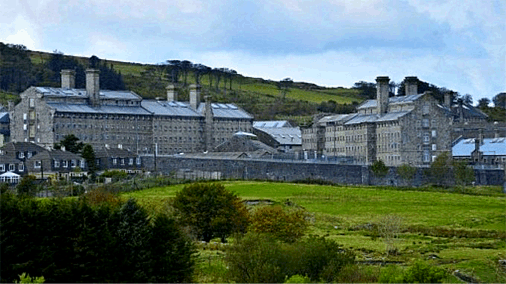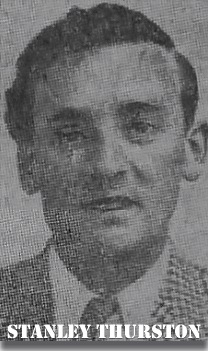
On the 26th of March 1941 the Western Morning News published the following report under the headline of ,”Vanished from Dartmoor.” It read:
“Stanley Thurston the man who boasted that no English goal could hold him, escaped from Dartmoor Prison yesterday morning and was still at large up to a late hour last night. The method by which he made his getaway is a complete mystery to the prison authorities, and will be the subject of an official enquiry. His absence was discovered at 9.oo a.m. after the prisoners had had their breakfast, and it is not known how the prison officer responsible for unlocking Thurston’s cell failed to detect his escape. He left no trace of how he got out of his cell, and there is no clue as to how he escaped from the prison precincts.
He is believed to have stolen a prison officer’s bicycle and ridden to Merrivale, a moorland hamlet a few miles to the west of Princetown. There he abandoned the cycle and took a motor-car which had been left in the car-park of the Merrivale Inn. The car is an Austin 14h.p., coloured black and maroon, with a registration number B.N.D.829. The police are satisfied as to the bonifides of the owners, who were staying at the inn.
From Merrivale Thurston drove in the direction of Tavistock, where all clues as to his whereabouts ceased abruptly. It was later stated that the cart in which he made his getaway only contained two gallons of petrol. He is an expert car driver and it is surmised that he is heading to London, where he has many friends and accomplices. He had an excellent start as the car was missing at 8.15 am., and it was not until an hour later that his escape was discovered.
Evacuee boys on Dartmoor Ponies joined warders on horseback, police, local huntsmen, and military in an exhaustive comb-out of the Moor, which continued until dusk. Cars on all roads were stopped and searched and were not allowed to proceed until the identity cards of occupants had been examined.
The escaped man is 31-years-old, 5ft. 10ins. tall, and is described of medium build, with broad shoulders and fresh complexion, and brown wavy hair brushed back straight from the forehead. His eyebrows are fair, thin, and arched. He has blue eyes, a fairly broad nose and small, receding chin. His lower lip is thick and upper lip protruding. He has good teeth, small ears which protrude, is clean-shaven, and well spoken and is extremely plausible. Thurston was wearing prison clothes when he made his getaway. Thurston was serving a sentence of five years’ penal servitude and five years’ preventative detention for housebreaking and larceny and is described as an habitual criminal.”

Thurston’s claim that no goal could hold him came from the fact that previously he had escaped from Liverpool gaol in 1930. On this occasion he made his getaway by dashing through the streets dressed in a vest and shorts when he was simply assumed to be out running. In 1939 he was again interred in Lewes gaol where again he escaped and managed to avoid re-capture for six months. During this time he posed as the son of a knight whilst living in an expensive London apartment for about two months. he was finally caught when he attempted to pawn a ring. Thurston was still at large come the April of 1941 with no sign of his whereabouts. However on the 25th of August 1941 it was reported in the Evening Telegraph that Stanley Thurston had been re-captured at Kingston in Surrey after being at large for 152 days. It had taken the Scotland Yard detectives and uniformed police five months to locate him. His arrest came about when a woman reported to the police that she had seen a man climbing up a stackpipe. There then ensued a chase which ended up in the police capturing him when he was then taken to the police station, whilst there he once again attempted to escape by diving through a glass window. Whilst at Kingston Thurston was living under another alias – Mr. Marwood Jones although at the trial it later emerged that his real name was Alfred Ernest Yates.

It was revealed at his Old Bailey trial that when ‘Thurston’ was four years of age his father sadly died and his mother when he was sixteen and a half. He managed to get a college education in physics and engineering and later became a lab technician at the college. Following his mother’s death he met a man who led him down the path of petty crime and a two year spell in a probation centre. It was here he made his first escape and manged to run away but after being re-captured he was sent to borstal. On his release he gained employment as an assistant engineer in Manchester. Whilst in this employ he was accused by the works owner son of an offence to which he was found guilty and sent to Wormwood Scrubs. Following his release from Wormwood he then stole a motorbike and was again sent to prison, this time at Preston from where, as was his want, he managed to escape. Over his criminal career Thurston managed to rack up the following offences; 1927 – housebreaking, garage breaking, larceny, taking a motorcar without consent, jewellery theft totally nine convictions So all in all and living up to his claim that no gaol could hold him Thurston had manged to escape from; the Probation Centre, Liverpool Prison, Preston Prison, Lewes Prison, and Dartmoor Prison.
The sentence of the judge at the Old Bailey was seven years penal servitude to run concurrently with an unexpired term of three years penal servitude and a five year term of preventative detention. the Court Sergeant’s final words were; “You are undoubtedly a very experienced and clever burglar, and the public has to be protected from people like you!”
 Legendary Dartmoor The many aspects past and present of Dartmoor
Legendary Dartmoor The many aspects past and present of Dartmoor

Filmed with “Thurston” starring in “The Dark Road” 1948